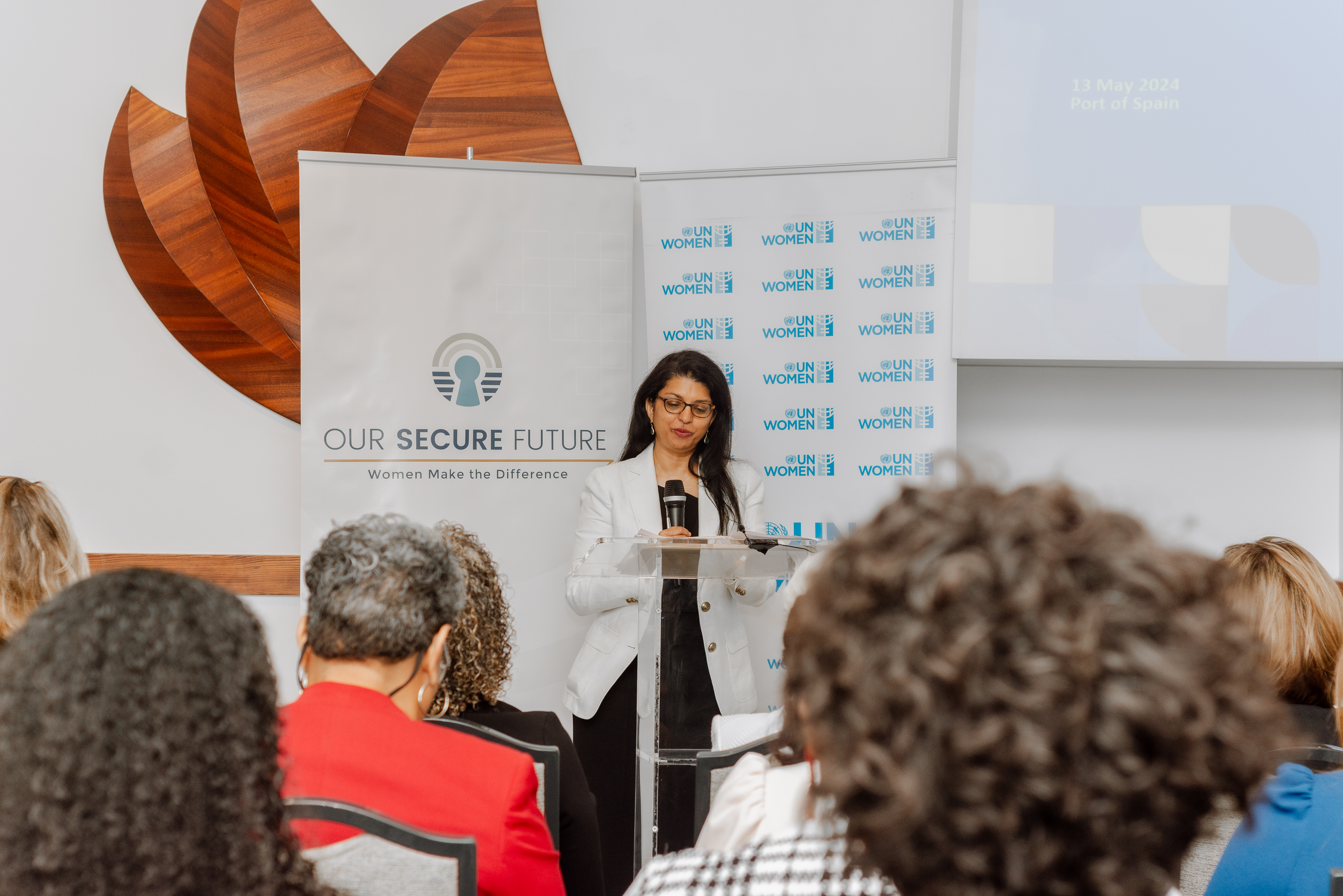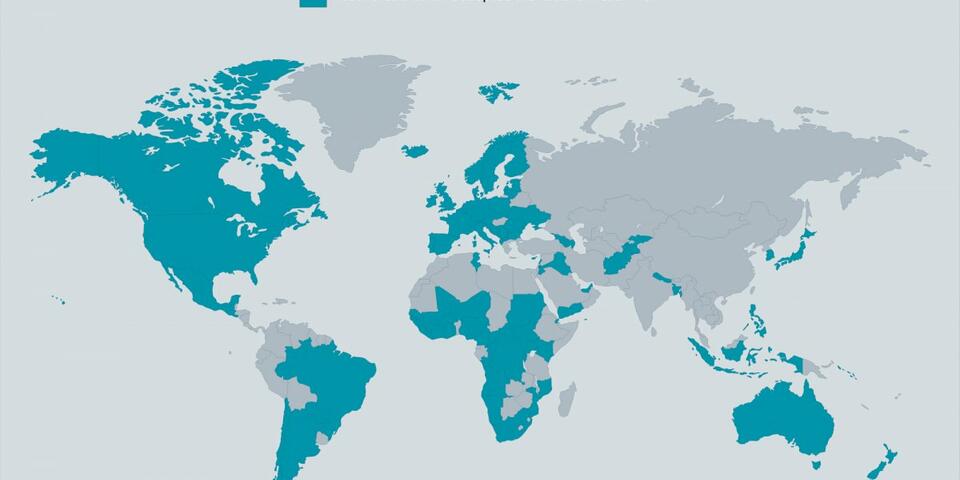What is the WPS National Action Plan Academy?
Our Secure Future's Women, Peace and Security (WPS) National Action Plan (NAP) Academy is focused on engaging countries and key policymakers to create and implement high-impact WPS National Action Plans. The WPS NAP Academy has a three-pronged approach:
-
Country engagement: includes direct assistance to government and civil society actors to create and implement high impact WPS NAPs.
-
Host one multi-country convening per year in partnership with major multilateral organizations such as NATO, OSCE, UN Women, the European Union, etc.
-
Thought leadership on policy, research, and innovative programming to enable policy decision-makers to create and implement high impact WPS NAPs.
WPS NAP Academy Theory of Change
-
If decision-makers have the technical skill and expertise to integrate a WPS lens;
-
If decision-makers have the skills and knowledge to create enabling conditions to develop, implement, and monitor WPS NAPs;
-
Then more countries will adopt and comprehensively high-impact NAPs on Women, Peace and Security, and there will be an increase in international peace and security.
What is a National Action Plan on Women, Peace and Security?
A WPS National Action Plan is a policy framework created by governments, regional institutions, and civil society to implement UN Security Council Resolution (UNSCR) 1325. The adoption of UNSCR 1325 on Women, Peace and Security in 2000 was a groundbreaking achievement for the inclusion of women and a recognition of their vital contributions to peace and security. UNSCR 1325 does more than pay lip service to the importance of women’s full participation in creating durable peace and security – it is a mandate that requires governments to act. In 2005, the UN Secretary General Special Report called on member states to create Women, Peace and Security (WPS) National Action Plans (NAPs) detailing how they will fulfill the mandate, to ensure that countries follow through with their commitments.
A unique feature of WPS NAPs is that they are intended to be developed with significant input from civil society and in collaboration with relevant international actors, including partner governments and WPS advisors. Civil society consultation is a key part of drafting the documents, and civil society actors are crucial in monitoring implementation by government actors and ensuring accountability for the commitments made. The goal is to produce meaningful advancement in the WPS agenda at the national and local level, with focus on supporting specific programs, practices, and policies that promote their inclusion. To date, more than 100 national governments and regional institutions have created NAPs.
Women, Peace and Security aims for better communication between governments, multilateral organizations, and civil society groups. A hallmark of an effective NAP on WPS is when all stakeholders work together within a context-specific framework to ensure the inclusion of women in peacebuilding and politics, and gendered protections from violent conflict.

2024 WPS National Action Plan Academy Regional Convening in the Caribbean
The first regional convening of the WPS National Action Plan Academy was held May 13-15 in Port of Spain, Trinidad and Tobago. Our Secure Future partnered with UN Women to bring together over 35 participants from the Caribbean, including government officials, regional partners, leaders from women’s and civil society organizations, and donor country representatives. The attendees participated in an intensive three-day workshop focused on designing and adopting high-impact National Action Plans (NAPs) in the region. Members of the newly appointed WPS Advisory Council of Trinidad and Tobago also participated.
Future partnered with UN Women to bring together over 35 participants from the Caribbean, including government officials, regional partners, leaders from women’s and civil society organizations, and donor country representatives. The attendees participated in an intensive three-day workshop focused on designing and adopting high-impact National Action Plans (NAPs) in the region. Members of the newly appointed WPS Advisory Council of Trinidad and Tobago also participated.
Through expert-led discussions, the workshop provided participants with actionable strategies and tools to help them prepare, design, and implement impactful WPS NAPs. The workshop facilitated cross-sector collaboration, highlighting the importance of gender equality in peace and security processes. Participants shared best practices in overcoming barriers, reaffirming their commitment to women's meaningful participation in addressing the Caribbean's security challenges. Read more about the convening here.
“We are aiming to advance the Women, Peace and Security agenda by underscoring that women are not just victims, which is the current narrative, but we see women as agents of change, in particular in securing a peaceful and more secure environment for all of us. Today we have about 110 countries that have adopted National Action Plans as a form of policy and practice to advance their national objectives ... we see countries continually not only adopting these Plans and creating a multi-stake holder process to do them but also renewing them year after year." - Our Secure Future Vice President Sahana Dharmapuri

Photo: Representatives of Caribbean states, United Nations organizations and Our Secure Future at the WPS National Action Plan Academy convening in Trinidad and Tobago. Photo credit: UN Women
The Current State of WPS National Action Plans
Globally, 107 countries have adopted National Action Plans (NAPs) on WPS since the adoption of UN Security Council Resolution 1325 in 2000. Despite this progress, women and girls continue to be disproportionately impacted by conflict and crises; high-rates of gender-based violence continue; and women are still routinely excluded from peace negotiations.
Unfortunately, decision-makers and policy makers continue to lack the technical skill and expertise, and political will needed to comprehensively implement the WPS agenda.
Women-led civil society organizations and networks are working tirelessly around the world to strengthen the implementation of WPS NAPs and Our Secure Future is uniquely positioned to support that work through the relationships we have built with key decision-makers and our team’s expertise. We believe that our specialty is providing support to policymakers and government officials whose commitment and action can translate policy commitments into concrete actions. That is why we have chosen to focus specifically on National Action Plans.
Fast Facts

Reflections from OSF NAP Fellow Miki Jacevic on the 15th Anniversary of NAPs (2020)
 In 2010, I started working on NAPs. For almost fifteen years before that, I had worked with many women leaders on the frontlines in conflict-affected countries. I was ever convinced that the WPS agenda will only prosper once we get official institutions, government officials, the international community, and foreign donors to actually take action to support these women. At the time, there were about 19 countries with NAPs, almost all of which were European donor nations. Canada’s Ambassador for Women, Peace and Security, Jacqui O’Neill, who was a colleague at the time, asked me, “now that you clearly are on this journey, what would success look like to you in ten years?”
In 2010, I started working on NAPs. For almost fifteen years before that, I had worked with many women leaders on the frontlines in conflict-affected countries. I was ever convinced that the WPS agenda will only prosper once we get official institutions, government officials, the international community, and foreign donors to actually take action to support these women. At the time, there were about 19 countries with NAPs, almost all of which were European donor nations. Canada’s Ambassador for Women, Peace and Security, Jacqui O’Neill, who was a colleague at the time, asked me, “now that you clearly are on this journey, what would success look like to you in ten years?”
We are now (incredibly) ten years later, at the 20th anniversary of UNSCR 1325. There are items to celebrate and still many more to keep working at.
I told Ambassador O’Neill that, in my dream, we would have about 60 countries with NAPs. We have far surpassed that goal. Today, there are 86 country NAPs, and I am working on six more, so hopefully by the end of this anniversary year we will reach 90 countries with a 1325 NAP. Similarly, almost all of the international, multilateral, and regional organizations – from NATO and EU to AU and ASEAN – have a plan and robust architecture on WPS. In most countries, NAPs are also aligned with other national priorities. Most exciting is the connection of the WPS agenda, including NAPs, with the CEDAW committee reviews – most nations are now required to report on General Recommendation No. 30, which includes specific inquiries around the country’s NAP, its implementation and budgeting.
Having worked with 50 countries in the development of their NAPs, I remain ever more committed and impressed, above all, to the transformative potential of the NAP process. It is so unique to get Ministries of Defense and Interior to sit together with Social or Women’s Ministries and civil society. Having had a privilege of seeing this process in some countries unfold for a number of years, I can speak to its value not just to create action on WPS, but, in general, to advance the needed understanding of inclusive governance as a key strategy to address many societal challenges across all countries, not just in those affected by violence and conflict.
Additional Resources
- Babic-Svetlin, K., Jacevic, M. & Mansury, M. “Localization of Women, Peace, and Security Agenda: Case Study of Six Local Governments in Bosnia and Herzegovina,” Inclusive Security & Agency for Gender Equality, Ministry for Human Rights and Refuges Bosnia and Herzegovina (2016).
- Cabrera-Balleza, M. & Popovic, N. Costing and Financing 1325, ICAN, Global Network of Women Peacebuilders & Cordaid (2011).
- Holt-Ivry, O. & Jacevic, M. “How to Include Women in the Peace and Security Agenda,” The New Humanitarian (2017).
- Inclusive Security. National Action Plans 101.
- Jacevic, M., Shean, A. & Whitman, T. Inclusive Security: A Curriculum for Women Waging Peace, The Institute for Inclusive Security (2009).
- Jacevic, M. “WPS, States, and the National Action Plans,” Chapter 22 in The Oxford Handbook on Women, Peace and Security, ed. True and Davis, Oxford University Press (2018).
- Jacevic, M. “How can we increase the impact of National Action Plans on United Nations Security Council Resolution 1325?,” Gender Associations International Consulting (2019).
- Jacevic, M. “What makes for an effective WPS national action plan?,” Australian Strategic Policy Institute (2019).
- Lippai, Z. & Young, A. “Creating National Action Plans: A Guide to Implementing Resolution 1325,” Inclusive Security (2017).
- LSE Centre for Women, Peace and Security & University of Sydney WPS National Action Plans.
- Tamaru, N. & Jacevic, M. “How localization supports practical solutions for women, peace, and security,” CDA Collaborative Learning Projects (2020).
- Tucci, R. & Luu, T. “How to Win on Women, Peace and Security,” United States Institute of Peace (2019).
- WILPF National-Level WPS Implementation.


